Fly Fishing 101, Part 32
Check Your Surroundings For Better Fishing
by Al Campbell
"Whacha usin'?" "Flies." "What kinda flies?" "Hoppers."
"Why?" "Cause they worked last year." "But there's no hoppers
out this time o'year." "Yea, but the fish like 'em. They bit 'em
last year, so they should bite 'em now." "Caught any?" "Naw,
they ain't bitin'."
Sound a little familiar? I've heard
conversations like this one many times in the 34
years I've been fly fishing. You'll have a hard time
convincing the guy with the hopper that the reason
they aren't biting is because he's using the wrong fly.
After all, hoppers worked great last August, therefore,
they must be a good fly. Trout loved them last year,
so they must love them this year.
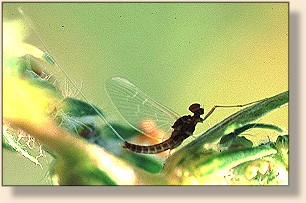 How do you select the right fly for
the job? Do you rely on the advice of someone
who isn't catching fish? What's your favorite fly? Do
you use it all of the time, or do you use it only when
the insect it matches is present? Do you know what
flies are hatching? How, you might ask, does
anyone really know what fly to use?
How do you select the right fly for
the job? Do you rely on the advice of someone
who isn't catching fish? What's your favorite fly? Do
you use it all of the time, or do you use it only when
the insect it matches is present? Do you know what
flies are hatching? How, you might ask, does
anyone really know what fly to use?
You need to forget about asking
the guy who's not catching fish. The only advice he'll
give you is bad advice. The only advantage you gain by
asking a fish-less person what he's using is knowing
what not to use.
You also need to forget the notion
that one fly works better than the rest. Sure, certain
flies are consistently more productive during the summer
than some other flies, but that's because the insects
they imitate are present that time of year. Hoppers, for
instance, are abundant in August, and a hopper pattern
is a great choice then. But, they aren't likely to work in
March. The fish only eat what's on the floating menu in
front of them, and hoppers aren't on that menu in the spring.

The first step to successful fly fishing,
is not fishing. First, you need to observe what's
happening around you. Put on your Sherlock Holmes hat
and do some investigating, maybe fifteen minutes
worth. What are the fish doing? What clues are around
you that will lead you to any hatches that are occurring?
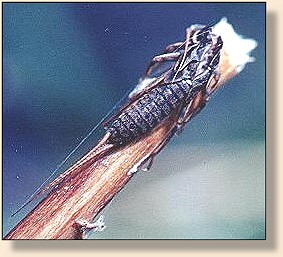
Take a look at grass stems and weeds
near the shore line for clues of a recent hatch.
Stonefly nymphs crawl out of the water to hatch into adults.
This transformation occurs on weeds, grass,
rocks and anything else handy near the shore line. Are
their cases present anywhere? Mayflies molt
after they hatch. This also occurs on grass and weeds.
Can you find any clues of a recent mayfly hatch?
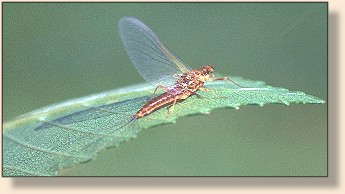
While you look for clues of a recent
hatch, see if any aquatic insects are crawling around
on nearby bushes. Streamside brush is a great hangout
for aquatic insects that have recently hatched and are
waiting their turn in the egg laying cycle. If you see a lot
of a certain kind of insect hanging around the brush,
you can bet on patterns that imitate that insect when you get to the stream.
Spider webs are a great place to look
for clues. Spiders make a habit of catching insects
that fly around their web. If the web is loaded with
unfortunate mayflies, the fish are probably loaded with
them too. Here's a perfect opportunity to match the size,
shape and color of the fly without trying to catch one
on the water.

What are the fish doing? Are they
rising to flies, and can you see the fly they're eating?
If you don't see rising fish, it's not very likely that they'll
eat a fly floating on the surface. If you don't see
them rising, a nymph might be in order. After all, nymphs
are available to them all of the time.
Is there a cloud of caddis flies hovering
above streamside brush? Caddisflies are a
common sight in the summer hovering above willows
and brush. If you see something that looks like a cloud
of tiny moths dancing around a streamside willow, grab
your box of caddis imitations and start flogging
the water with one, you've just solved a mystery.
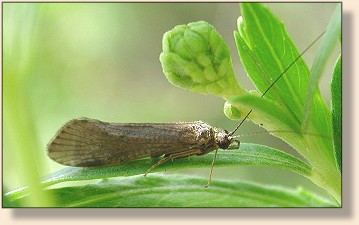
I'm not fond of stomach pumps,
they can kill fish if they're used wrong. But, if you catch
a fish and check the contents of it's stomach, you will
have a good idea of what that fish was eating. If it has a
belly full of green beetles, all the hoppers in your fly box
won't change it's mind about what's on the menu.
A net made of fine mesh stretched
between two rods is a good tool to find out what's
floating down the stream. Stretch the net across the
water near the shore, and see what floats into it.
Then try the same thing in the middle of the stream.
The results might differ a little between the middle
and the edge of the stream, but if you see lots of the
same insect in both nettings, you'll have a good idea
of what you should be using.
A notebook to record your findings
for future reference is a valuable tool. You might
be surprised how accurately those findings compare
with your observations a year later on the same body
of water. In a couple of years you should have a good
data base to use when selecting flies for your
upcoming fishing trip.
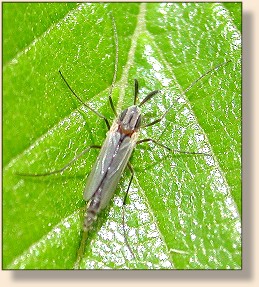 Fifteen minutes spent searching
for evidence of the current insect hatches can save
you hours of pure frustration on the water.
Fifteen minutes spent searching
for evidence of the current insect hatches can save
you hours of pure frustration on the water.
While the other fishermen are flogging the water with the flies
that worked last August, or the fly the last fish-less angler
was using, you can have your list of flies reduced
to the few insects that are currently active on the water.
All it takes is a few minutes of observation without
a fly rod in your hand.~ Al Campbell
Beginners Archives
|